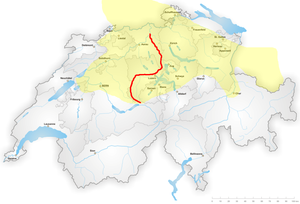Highly Alemannic

High Alemannic is an Upper German dialect form in large parts of German-speaking Switzerland , in Liechtenstein , in parts of southern Baden (south of Freiburg ), in the Alsatian Sundgau and in some areas in Vorarlberg in Austria . Characteristic of the high Alemannische the displacement is of germanic k in the initial sound to ch " K ind" and " K opf", for example, correspond to High Alemannic German " Ch ind" and " Ch opf". This demarcation is also known as the Sundgau-Bodensee barrier .
structure
Eastern High Alemannic (Eastern Swiss German)
In Switzerland :
-
Northeast Swiss : Summary of various closely related dialects in Eastern Switzerland, e.g. B. the Thurgau (in the canton Thurgau ) and the Schaffhauser (in the canton Schaffhausen → Schaffhausisch-Thurgauischer dialect area), but also
- St. Gallen German , more precisely Fürstenländisch, Toggenburgisch, Rheintalisch (in the canton St. Gallen )
- Appenzellian (in Appenzellerland )
- Bündnerdeutsch , more precisely Churerrheintalisch (around Chur, in the rule, in the five villages and younger starting from here, in the canton of Graubünden , but without Walsermund species)
- Zurich German (in the Canton of Zurich)
- eastern Aargau (in the canton of Aargau )
Outside of Switzerland (often counted as Middle Alemannic or Lake Constance Alemannic instead of High Alemannic ):
- Liechtensteinisch (in Liechtenstein )
- southern Vorarlberg (in the Austrian state of Vorarlberg )
Main feature
In the plural of verbs , the ending [ -əd̥ ] applies .
Transitional dialect between eastern and western High Alemannic
- Lucerne or Lucerne German (in the canton of Lucerne , without hinterland and Entlebuch)
- large parts of the Aargau
Depending on the criterion, the dialects belong partly to the Eastern (e.g. verbal unit plural or closed pronunciation of / e / in bed or / o: / in Broot ), partly to the western (e.g. two-form verbal plural or open pronunciation of / e / in Bètt and / o: / in Bròt ) group to.
Western High Alemannic (French-speaking German)
(Switzerland only :)
- western Aargau (in the canton of Aargau)
- Basellandschäftlerdeutsch (in the canton of Basel-Landschaft )
- Bern German (in the Bernese Mittelland )
- Fricktalerisch (in the Fricktal )
- Solothurn (in the canton of Solothurn )
Main feature
The verbs know two plural forms [ -ə -ət -ə ] instead of the unit plural .
South Baden
- Southern Freiburgisch (south of Freiburg im Breisgau )
- Markgräflerlandisch (in the Markgräflerland )
- Southern Black Forest (in the Southern Black Forest )
Sundgauian
This southernmost of the Alsatian dialects is spoken in the French Sundgau .